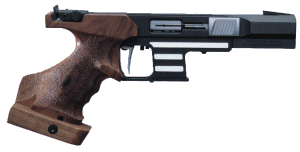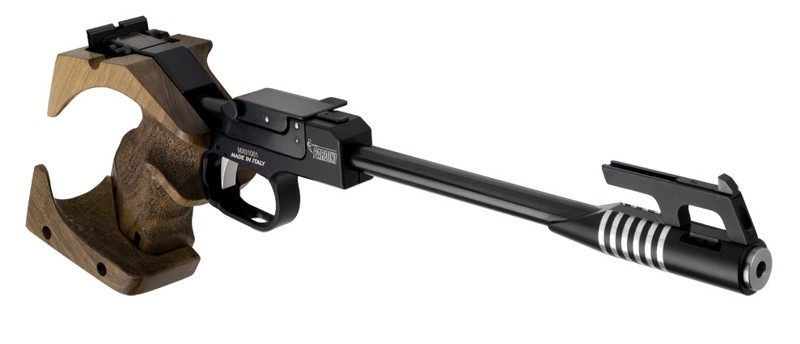One of the most common topics of discussion on gun websites, magazines, and TV shows is the weight of the trigger pull of gun X. Usually heard as “my CQB Tactical Destroyer has a 2.5 pound trigger pull!” or “I had to use a fish scale to measure the trigger pull of the Hi Point it was so heavy”. Many pixels have died to bring us this information, and yet for whatever reason people seem to think a light trigger pull is almost a badge of honor. I recently met a guy that was talking about how he had his Glock trigger down to 2.5 pounds or some absurd number, which made me wonder “why?”
I tend to fall in the school of thought that thinks that a light trigger pull isn’t necessarily a good thing for self defense, or even for competition. Here’s the logical process behind that though – I started shooting serious competitions at the Academy for the collegiate pistol team. I used an earlier version of the Pardini SP pistol in .22,  which being a bullseye .22 had a trigger pull that was adjustable. I was essentially issued this gun by the team, and I never bothered with screwing around with adjusting the pull, I’d imagine based on current knowledge that it was probably around 2.5 pounds, which was plenty light.
which being a bullseye .22 had a trigger pull that was adjustable. I was essentially issued this gun by the team, and I never bothered with screwing around with adjusting the pull, I’d imagine based on current knowledge that it was probably around 2.5 pounds, which was plenty light.
I also competed in Free Pistol, or 50m Pistol as it’s known elsewhere. Free pistol is a weird bullseye sport that uses guns that have evolved to the point where they don’t really resemble firearms any more.
 The Pardini pictured at left has a factory trigger pull of 50 grams – that’s 0.11 pounds if you’re wondering. For reference, a quarter weighs about 6 grams, so a stack of 9 quarters would be enough to make this gun go “bang”.
The Pardini pictured at left has a factory trigger pull of 50 grams – that’s 0.11 pounds if you’re wondering. For reference, a quarter weighs about 6 grams, so a stack of 9 quarters would be enough to make this gun go “bang”.
Now, you’d think that because my real introduction to serious shooting was with high end competition guns with great triggers that I’d demand light trigger pull weights on all my guns – but it’s precisely the opposite. Coming in to shooting from NRA Collegiate Pistol taught me that the most important thing in the world isn’t the weight of your trigger, but how you manage the trigger. With a 0.1 pound trigger, any mashing or jerking is magnified significantly, and turns a 10 into an unacceptable 7.
Fast forward 10 years, and now the lightest trigger pull on any of my competition guns comes in around 9 pounds. Yes, I shoot revolvers exclusively, but even though the triggers are heavy doesn’t mean they’re bad. Personally, the most important factor in whether or not a trigger is good or bad isn’t the weight, but rather how smooth it is. I’ll take a 12 pound double action revolver trigger that’s nice and smooth over a gritty, stacking 5 pound trigger any day of the week. Even Jerry Miculek is credited with saying that the best action job you can give a revolver is to dry fire it 3000 times; from personal experience I can tell you that doing that will make the bearing surfaces plenty smooth.
The point of all of this is to establish that you don’t need a light trigger to shoot well – in fact a light trigger can actually hurt your ability to shoot well by masking flinch and jerk that would affect shots if fired from a “duty” trigger pull. If you’re shooting IDPA or USPSA there isn’t any reason to screw around with the pull weight on your gun unless you’re running head to head with Dave Sevigny and need to shave 0.003 seconds off your splits. Shooting a gun with a light trigger isn’t going to make you a better shot – but practicing your trigger pull with lots and lots of dry fire or a Crimson Trace laser will.
Amen.
How do you feel about rifle triggers? My Savage 110 had the trigger pull from hell…you needed to be Ahnold to grunt and squeeze that thing without wandering all over the target. I had a gunsmith measure it, but he couldn’t…his digital trigger pull gauge only went up to 10 pounds. I had it replaced with a Timney unit, set to 3.5 lb., and now the broad side of the barn can actually be hit. (Note: This was before the current generation of “AccuTrigger” was available).
I don’t really have an opinion on rifle triggers, but that’s mostly because I’ve not shot a whole lot of rifles outside of .22s and AR pattern rifles. That being said though, I guess I’d probably feel the same way about rifle triggers as I do for handgun triggers – unless you’re running a highly specialized custom rifle for shooting at super long ranges, you don’t need a 2 pound trigger on an AR. But that’s all through my personal lens of “I shoot targets for fun”.
I agree, you can have too light a trigger, and a heavier trigger can be managed if it is smooth.
Once you get over around 15 lbs, it does get harder to do the deed, and if you add in roughness it’s worse.
But a good trigger, is not always a light trigger
I couldn’t agree with this post more.
Maybe it’s because my first handgun was a revolver that I usually fired double-action but I prefer a heavier trigger than most. For instance on my Glocks I always drop an NY1 trigger spring in because I like the way an ~8lbs. feels better than the stock ~5.5lbs. trigger pull.
I’ve shot a bunch of “Mass Legal” M&Ps, and while the trigger pulls is a higher 10 pounds, its still a pretty darn smooth pull with no stack, take-up or overtravel. Depending on your hand strength, you might find a lighter trigger more manageable, but for most it shouldn’t be an issue.
On Sig Sauers, I LOVE their DA trigger pull, and HATE the SA pull because its so damn mushy with all the slack they leave on the trigger.
Weight is NOT as important as smoothness, and the quality of the pull.
True, light doesn’t necessarily equal good. On the other hand a very heavy pull always equals bad. I don’t consider 8-10 pounds very heavy. If the trigger pull is so heavy that my hand starts to shake before it breaks, there is no way I can hit anything with that gun even if it is the smoothest pull ever. And I’ve had that happen with some bad double action triggers.
There is such a thing as “too heavy”, that I do agree with. Like any post full of sweeping generalizations, your mileage may vary depending on factors like hand size and strength.
For myself, the length of the pull makes much more difference than any other factor. I’d rather have heavy and short than light and long.
That’s one reason I’ve never liked revolvers. I have a very difficult time holding the sights on target through the long, heavy trigger pull. I’d probably get better with practice, but I simply don’t like shooting them so I don’t.
In fact, other than the two wall hanger family heirlooms that I never shoot, the only serviceable revolver I own is a single-action cap and ball revolver that my dad put together from a kit in the ’70’s.
For single action guns though, there’s no real reason I can think of to have a trigger pull over say 6 or 7 pounds. I prefer mine to be somewhere around 4 or 5. If you get much lower than that, I think you start getting into the danger zone for unintentional discharges. As long as it’s a range gun, that may be acceptable, but for working guns that would cause me some concern…and, as you said, smooth takeup, minimal creep and a clean break are much more important than a pound or two of trigger pull weight.
When I first started shooting the DA wheelies I had trouble managing the long trigger pull as well. In fact, back in the dark days of shooting Taurus guns, I usually shot my DA wheelguns by cocking the hammer and shooting them single action.
The single thing that had made me better at shooting a DA revolver has been massive amounts of dry fire. I’ll probably dry fire 1,000 reps a week with my various competition guns, and that’s made a monster difference in my shooting.
Besides being absolutely subjective. A good trigger pull for a standard striker fired pistol is between 3.5-4lbs. Preferably 4lbs. I compete with a 4lb trigger, and my carry gun is 4lbs. There comes a point where your equipment is too good, and doesn’t resemble anything you would carry in the outside world. I think that is a dangerous step to take because one thing that IDPA/USPSA is is practice. We must at least practice with equipment that has some modicum of resemblance to what we carry in the real world. If shoot equipment that is so tricked out and carry something that is nowhere near that, how can I reasonably be expected to operate effectively in a real situation when I generally unfamiliar with my equipment?
I shoot a Glock 17 competitively and carry a Glock 26.